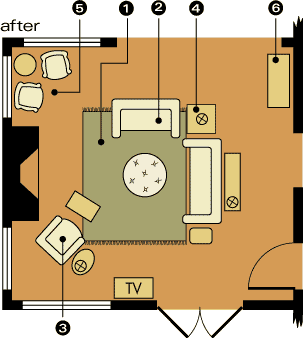
|
|
|
|
| HOME & GARDEN ARTICLES |
Floorplans for Tricky Rooms
Content provided by Better Holmes & Garden
Curing an Awkward "L"
The problems
The love seat sits too far away from the sofa for conversation and the space allotted to the piano is cramped. The sofa arm rests only a few feet from the dining room table, leaving no separation between the living and dining areas. The table is proportionately too small for the dining room. With no element more than waist tall, the design lacks height.
The solution
Group furnishings to create functional focal points. Increase the size of the dining table. Add new elements to create height and separation.
- Scale the size of the table to the room by adding a leaf to it and resting it on a large rug.
- Slide the buffet to the long wall and give height to the overall design with the addition of a china cabinet.
- Use a screen as a movable wall to break up a long expanse of wall and separate the rooms.
- Pull the love seat away from the wall to tighten the conversation area; slide a sofa table behind.
- Eliminate one chair and rotate the other in toward the seating pieces for conversation.
- Allow the piano its own space for easy access and separation of conversation and music time.
Dull & Boring
The problems
This plain boxy room needs livening up. The two focal points, the fireplace and the TV armoire, rest side by side, pulling too much attention to one side of the room. The game table overpowers a small corner, and the bookcases are lost in a sea of wall space. Traffic must negotiate a maze of furniture. Seating pieces are too far apart for easy conversation.
The solution
Use diagonals to relieve the monotony. Create separate focal points. Tighten up the furnishings, and straighten traffic pattern.
- Place functional furniture, such as a bench or a storage piece, near the entry.
- Nudge a rug up to the chair to bridge upholstered pieces and to balance the color flow.
- Place furniture to direct traffic around the conversation area and toward the focal points.
- Tuck a desk in the corner clear of the sliding doors for a cozy little work nook with a view.
- Balance big elements—a fireplace and TV armoire—on different walls.
- Soften and balance the TV armoire with a fabric-covered screen, a rug, and plants.
- Keep walkways free of furniture; allow at least 36 inches for easy flow of traffic.
Cramped Quarters
The problems
This tiny room is burdened with two entrances. The narrow traffic path slices through the conversation area.
The solution
Create two conversation stations, bridged by the rug. Open up a traffic path, and add some visual height to the design with elements that lift the eye.
- Balance lighting around the room; consider both task lighting and mood lighting.
- Center the love seat in front of the windows and nudge the sofa in close for conversation.
- Slide tail table away from the center of the room, opening a walkway for traffic.
- Lay a large rug on the floor to warm a conversation area and to bridge pieces of upholstery.
- Angle the chairs for intimate conversation. Use a tree to soften the corner behind the chairs.
- Balance the visual weight of doorways and windows with the height of a secretary desk.
The Big Box
The problems
This room has the appearance of a large, empty box with the furniture pushed up against the walls. With the chair backs against the railing, conversation is closed off between guests in this room and those in the kitchen. The seating is limited, leaving a lot of wasted space. Yet, the sofa and chair crowd the walkway into the room.
The solution
Create the illusion of a cozier space by bringing the upholstery pieces closer together. Offer your guests more seating options for reading, enjoying the fire, or chatting. Leave the railing area and the entrance into the room more visually open to encourage the blending of conversation between guests in both rooms.
- Slide the game table into the corner so it is somewhat removed from the sitting area.
- Toss a large area rug on the floor to bridge the gap between seating pieces.
- Snuggled up to the fire for quiet reading, a chair is still within reach of the conversation area.
- Slide a table behind the sofa and top it with a lamp to balance the room's lighting.
- Make the room more inviting and accessible to your guests by leaving the walkway open.
- Surround a coffee table with furniture to include it in the group instead of floating alone.
- Provide more seating by adding a love seat, or change to a wraparound sectional.
- Soften a corner's hard edges and build up some visual height behind the sofa with a tree.
Too Square
The problems
All walls are created equal in the square room, which means there's no narrow space that naturally pulls seating pieces together. The temptation is to scatter furniture helter-skelter, filling every corner with seating. The result looks fragmented and unformed; worse, the arrangement doesn't work well when it's time to talk.
The solution
Create a smaller square for conversation within the larger dimensions of the room. Instead of starting out by the walls, start in the center of the room and work outward with your major pieces of furniture. Ground the grouping with an area rug, and fill it out with adequate lighting.
 |
 |
- Lay down an area rug first, to define your conversation space.
- Don't point all your seating pieces at a single focal point, such as the fireplace, to the detriment of another practical view, such as the TV. An L-shape seating arrangement accommodates warming up to the fire and catching the game on the tube.
- Don't leave your arrangement open-ended. Station a chair, ottoman, and end table in the corner, facing into the grouping.
- Place an end table between the sofa and love seat, with a lamp that illuminates both; and include a sofa table behind the sofa with another lamp for lighting the far end of the sofa.
- The well-furnished room needs attention in the corners, even though these don't participate in the main conversation grouping. Place two chairs between a small, shared side table in the vacant corner of the room. This provides a quiet spot for private conversation, even when the TV is on.
- A narrow bookcase, sideboard, or console table fills a corner with display space without getting in the way of traffic.
Nooks and Crannies
The problems
This room is plagued by bump-outs and awkward niches. Plus, having an opening on every wall leaves limited wall space for placing furniture. The fireplace is off-center and battles the bay window for focal-point status.
The solution
Create vertical lines to lift the eye and give the illusion of more space. Tall furniture can build height and fill the corners of the room. For instance, slip a bookcase next to an off-kilter fireplace and offset a large window with a corner cabinet and room-softening plants. Make use of narrow bump-out spaces with filler tables for display or storage. Pull seating pieces away from small walls and snuggle them together for coziness. Finally, highlight the room's good qualities with light.
- Add built-in or freestanding bookcases to fill fragments of space and offer more storage.
- Slide the coffee table in front of the chairs and out of the way of traffic entering the room.
- Pull the sofa close to the chairs. A sofa table fills the niche and holds a task lamp.
- Put a corner to good use and balance the room's vertical openings with a tall cabinet.
- Separate chairs with a large round table to loosen a grouping and allow in more light.
- A tree or a cluster of tall plants joins the corner cabinet in framing the large window.
Long and Narrow
The problems
The fireplace, on one of the room's short walls, is the focal point. The long sofa can't be pushed closer to the fireplace because it would create a traffic block. However, lining up the furniture along the walls creates a static, waiting-room feeling and leaves too much distance between pieces for conversation. The piano is crammed into a small corner next to the fireplace, putting two heavy pieces on one end of the room. A large area rug overpowers the small room.
The solution
Replace the sofa with a love seat for flexibility in a narrow room. This one can be snuggled up to the fireplace. Pull the chairs away from the window—where they block both architecture and light—and let them flank the fireplace, encouraging conversation.
- Turn a plain corner into a quiet reading nook with a chair, ottoman, and lamplight.
- A narrow, low bookcase holds books and knickknacks without blocking light or traffic.
- A small area rug bridges the gap between seating pieces to define and warm the conversation area.
- Move big items, such as a piano, away from the room's focal point for better balance.
- Push a love seat closer to the fire. Replace traffic-blocking end tables with a sofa table.
- Don't have a fireplace to anchor your scheme? Create a focal point with a wall unit or armoire.
Split Focus
The problems
Traffic travels between the doorways, dividing the room into two separate conversation areas. The arrangement is static and doesn't take advantage of the view out the window.
The solution
Slide your main conversation grouping, the sofa and club chairs, over by the picture window for a better view. Place the sofa perpendicular to the window so that it blocks neither the window nor access to the other side of the room. Across the room, float a single chair in the corner for solo pursuits. It can also be easily pulled into conversation. For balance, move the game table to the corner opposite the sofa. The game chairs can also be rotated and pulled in to join the sofa.
- Slide a table behind the sofa to hold a lamp and to center the sofa and chairs by the window.
- Reserve the center of the room as a walkway for traffic. Keeping it obstacle-free.
- Angle a chair by the electronics cabinet for quiet enjoyment. Provide a lamp for reading.
- Angle the chairs for closer conversation. The lamp balances other light sources in the room.
- Drop a large rug between the sofa and chairs to soften and define the conversation area.
- Balance the room's weight by sliding the table to the opposite corner of the sofa.
|
|
 |

|
|

